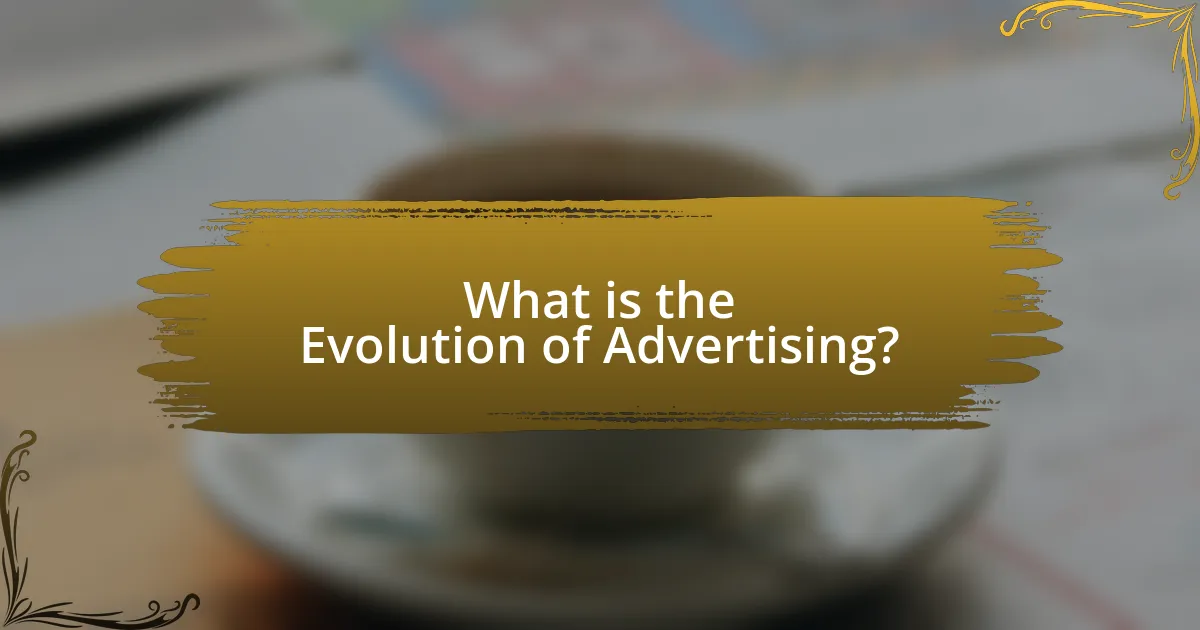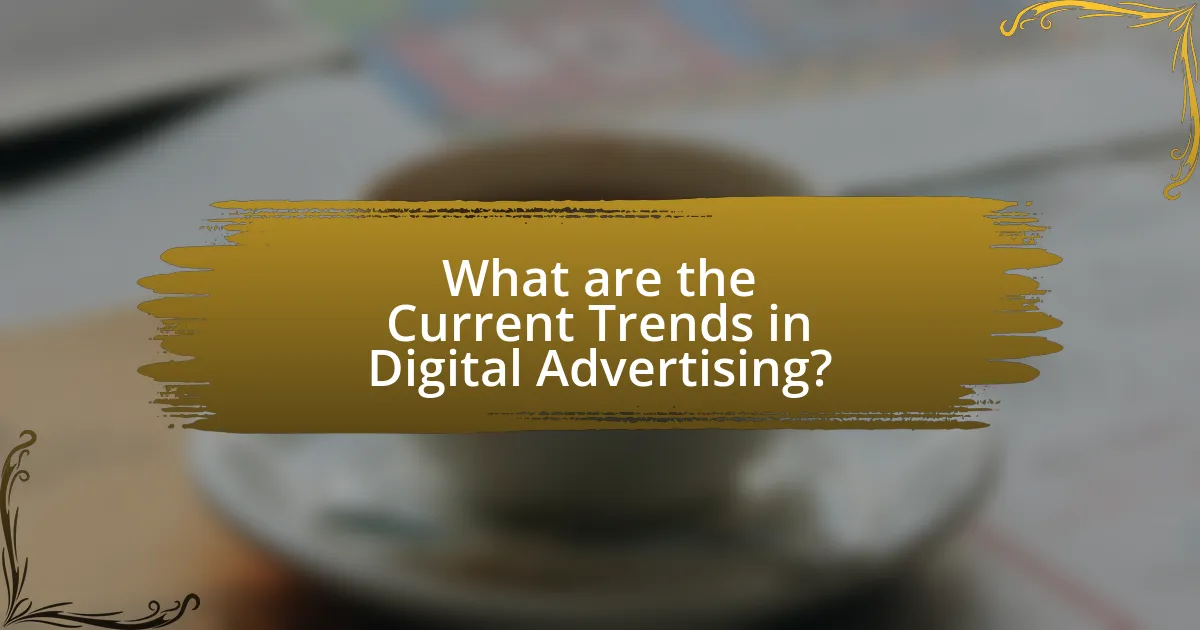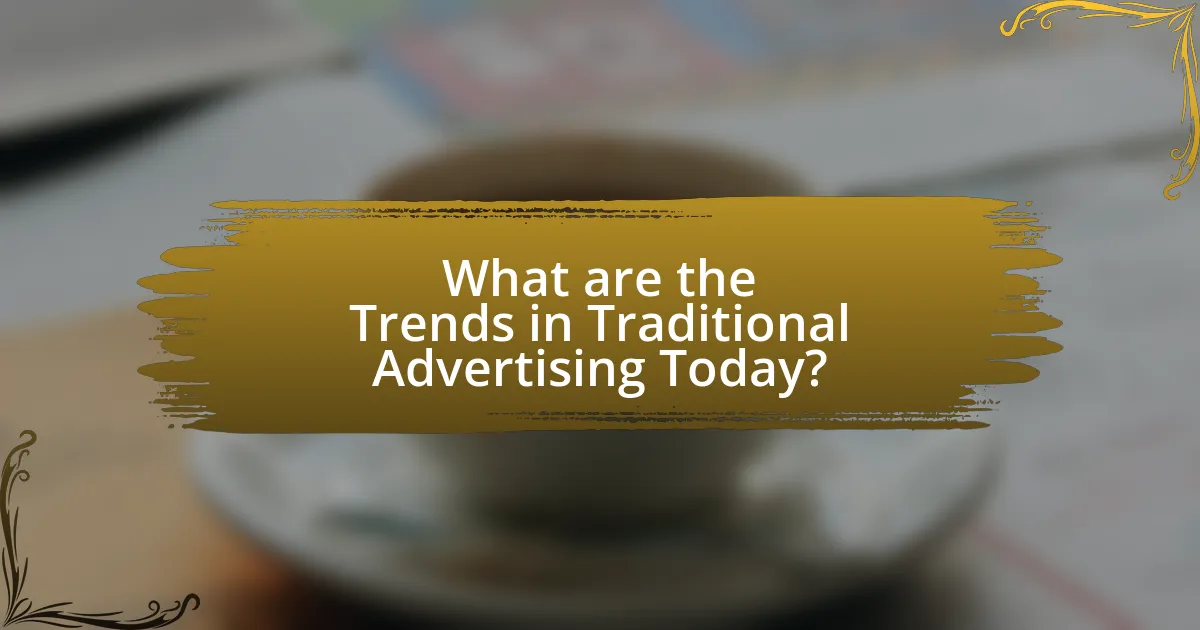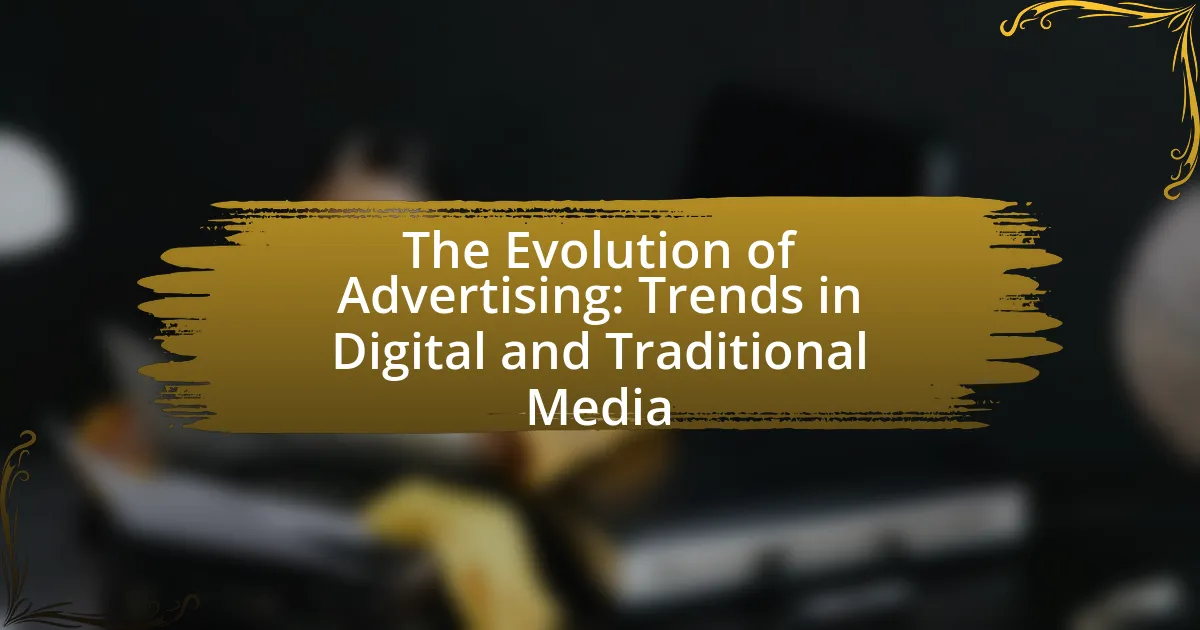The article examines the evolution of advertising, highlighting the transition from traditional methods to digital platforms influenced by technological advancements and changing consumer behaviors. It outlines key milestones in advertising history, such as the invention of the printing press and the rise of the internet, which have shaped current advertising practices. The discussion includes the impact of digital advertising trends, such as the use of artificial intelligence, social media, and influencer marketing, while also addressing the ongoing relevance of traditional advertising methods. Additionally, the article explores the integration of digital and traditional strategies, the challenges faced by traditional advertising, and best practices for effective advertising across various platforms.

What is the Evolution of Advertising?
The evolution of advertising encompasses the transition from traditional methods to digital platforms, reflecting changes in technology and consumer behavior. Initially, advertising relied on print media, such as newspapers and magazines, which emerged in the 15th century with the invention of the printing press. By the 20th century, radio and television became dominant mediums, allowing advertisers to reach broader audiences through audio-visual content.
The rise of the internet in the late 20th century marked a significant shift, introducing digital advertising through websites, email, and search engines. By 2020, digital advertising expenditures surpassed traditional media for the first time, with platforms like Google and Facebook leading the market. This transition is supported by data from eMarketer, which reported that digital ad spending reached over $385 billion globally in 2020, highlighting the rapid growth and importance of digital channels in contemporary advertising strategies.
How has advertising changed over the decades?
Advertising has transformed significantly over the decades, shifting from traditional media to digital platforms. In the 1950s and 1960s, advertising primarily relied on print, radio, and television, focusing on broad audiences with mass marketing strategies. By the 1980s and 1990s, the rise of cable television and niche magazines allowed for more targeted advertising, enabling brands to reach specific demographics.
The advent of the internet in the late 1990s revolutionized advertising, introducing online ads, email marketing, and search engine optimization, which allowed for real-time analytics and targeted campaigns. In the 2000s and 2010s, social media emerged as a dominant force, enabling brands to engage directly with consumers and utilize user-generated content.
As of the 2020s, advertising continues to evolve with advancements in artificial intelligence and data analytics, allowing for hyper-targeted ads and personalized marketing experiences. This shift reflects a broader trend towards interactivity and consumer engagement, fundamentally changing how brands communicate with their audiences.
What were the key milestones in the history of advertising?
Key milestones in the history of advertising include the invention of the printing press in the 15th century, which enabled mass production of printed advertisements. In the 19th century, the first modern advertising agency, Volney B. Palmer, was established in Philadelphia, marking the beginning of organized advertising. The introduction of radio in the 1920s allowed for audio advertisements, while television in the 1950s revolutionized advertising with visual storytelling. The rise of the internet in the late 20th century led to digital advertising, with search engines and social media platforms becoming significant channels. Each of these milestones significantly transformed how products and services are marketed to consumers.
How did technological advancements influence advertising evolution?
Technological advancements significantly influenced the evolution of advertising by enabling more targeted, efficient, and interactive marketing strategies. The introduction of the internet in the 1990s revolutionized advertising, allowing businesses to reach global audiences through digital platforms. For instance, search engine optimization (SEO) and pay-per-click (PPC) advertising emerged, providing measurable results and precise targeting based on user behavior. Additionally, the rise of social media platforms in the 2000s further transformed advertising by facilitating direct engagement between brands and consumers, exemplified by Facebook’s targeted ad capabilities, which utilize user data to enhance ad relevance. These advancements have led to a shift from traditional media, such as print and television, to digital channels, where real-time analytics allow advertisers to optimize campaigns instantly, demonstrating the profound impact of technology on advertising strategies.
What are the main types of advertising?
The main types of advertising are digital advertising, print advertising, broadcast advertising, outdoor advertising, and direct mail advertising. Digital advertising encompasses online platforms such as social media, search engines, and websites, which have become dominant due to their ability to target specific audiences effectively. Print advertising includes newspapers, magazines, and brochures, which remain relevant for certain demographics. Broadcast advertising refers to television and radio commercials, which reach a wide audience but often at a higher cost. Outdoor advertising consists of billboards and transit ads, providing high visibility in public spaces. Direct mail advertising involves sending promotional materials directly to consumers’ mailboxes, allowing for personalized marketing. Each type serves distinct purposes and audiences, contributing to the overall advertising landscape.
What distinguishes traditional advertising from digital advertising?
Traditional advertising is distinguished from digital advertising primarily by its medium and interactivity. Traditional advertising utilizes print, television, radio, and outdoor formats, which are generally one-way communication channels where the audience receives the message without immediate feedback. In contrast, digital advertising employs online platforms such as social media, websites, and email, allowing for two-way communication and real-time interaction with the audience. According to a 2021 report by Statista, digital advertising spending surpassed traditional advertising for the first time, highlighting the shift in consumer engagement and the effectiveness of targeted campaigns in the digital realm.
How do various advertising mediums impact audience engagement?
Various advertising mediums significantly impact audience engagement by influencing how effectively messages are communicated and received. Digital mediums, such as social media and online video, often yield higher engagement rates due to their interactive nature, allowing audiences to comment, share, and participate in real-time. For instance, a study by HubSpot found that social media posts with images receive 650% more engagement than text-only posts, demonstrating the effectiveness of visual content in capturing attention. In contrast, traditional mediums like television and print can create a more passive viewing experience, yet they still hold value in reaching broad audiences; Nielsen reports that TV advertising still reaches 90% of adults in the U.S. weekly. Therefore, the choice of advertising medium directly affects the level of audience engagement, with digital platforms generally fostering more interaction compared to traditional formats.

What are the Current Trends in Digital Advertising?
Current trends in digital advertising include increased use of artificial intelligence, personalization, video content, and influencer marketing. Artificial intelligence enhances targeting and optimization, with 80% of marketers reporting improved efficiency through AI tools. Personalization is crucial, as 72% of consumers expect personalized experiences, leading to higher engagement rates. Video content continues to dominate, with 86% of businesses using it as a marketing tool, capitalizing on its effectiveness in capturing audience attention. Influencer marketing is also on the rise, with the industry projected to reach $16.4 billion in 2022, reflecting its growing importance in brand promotion.
How is social media shaping digital advertising strategies?
Social media is significantly shaping digital advertising strategies by enabling targeted advertising and fostering direct engagement with consumers. Platforms like Facebook and Instagram provide advertisers with sophisticated tools to segment audiences based on demographics, interests, and behaviors, allowing for personalized ad experiences. According to a 2022 report by Statista, 73% of marketers believe that social media marketing has been effective for their business, highlighting its impact on advertising effectiveness. Additionally, social media facilitates real-time feedback and interaction, which helps brands adjust their strategies quickly based on consumer responses, further enhancing the relevance and effectiveness of their advertising efforts.
What role do influencers play in modern advertising?
Influencers play a crucial role in modern advertising by acting as trusted intermediaries between brands and consumers. Their ability to engage and connect with specific audiences allows brands to leverage their credibility and reach, resulting in higher engagement rates compared to traditional advertising methods. According to a 2021 study by the Digital Marketing Institute, 49% of consumers rely on influencer recommendations when making purchasing decisions, highlighting the effectiveness of influencer marketing in driving consumer behavior.
How does data analytics enhance targeting in digital campaigns?
Data analytics enhances targeting in digital campaigns by enabling marketers to identify and segment audiences based on specific behaviors, preferences, and demographics. This capability allows for more personalized and relevant advertising, which increases engagement rates. For instance, a study by McKinsey found that companies using advanced analytics for customer segmentation can achieve up to a 10% increase in sales. By analyzing data from various sources, such as social media interactions and website behavior, marketers can tailor their messages and offers to meet the unique needs of different audience segments, ultimately improving campaign effectiveness and return on investment.
What emerging technologies are influencing digital advertising?
Emerging technologies influencing digital advertising include artificial intelligence (AI), augmented reality (AR), virtual reality (VR), and blockchain. AI enhances targeting and personalization by analyzing consumer data, leading to more effective ad placements; for instance, AI-driven algorithms can increase click-through rates by up to 50%. AR and VR create immersive experiences that engage users, with AR ads reported to increase engagement by 70% compared to traditional formats. Blockchain technology improves transparency and trust in advertising by providing verifiable data on ad placements and performance, reducing fraud in the industry. These technologies collectively reshape how brands connect with consumers, driving innovation in digital advertising strategies.
How is artificial intelligence transforming advertising practices?
Artificial intelligence is transforming advertising practices by enabling hyper-targeted marketing and automating content creation. AI algorithms analyze vast amounts of consumer data to identify patterns and preferences, allowing advertisers to deliver personalized messages to specific audiences. For instance, a study by McKinsey & Company found that companies using AI for marketing can achieve a 10-20% increase in sales through improved targeting and customer engagement. Additionally, AI tools like natural language processing and machine learning facilitate the generation of ad copy and visuals, streamlining the creative process and reducing costs. This shift not only enhances efficiency but also improves the effectiveness of advertising campaigns, leading to higher return on investment for businesses.
What impact does augmented reality have on consumer experiences?
Augmented reality significantly enhances consumer experiences by providing immersive and interactive environments that engage users more deeply than traditional media. This technology allows consumers to visualize products in their real-world context, leading to increased confidence in purchasing decisions. For instance, a study by the Harvard Business Review found that 61% of consumers prefer retailers that offer augmented reality experiences, as it helps them better understand products before buying. Additionally, augmented reality can increase brand loyalty and customer satisfaction by creating memorable interactions, as evidenced by IKEA’s app, which allows users to see how furniture fits in their homes, resulting in higher conversion rates.

What are the Trends in Traditional Advertising Today?
Trends in traditional advertising today include a resurgence of print media, increased integration with digital platforms, and a focus on local targeting. Print media, such as magazines and newspapers, has seen a revival as consumers seek tangible experiences, with a 2022 report indicating that 79% of consumers trust print ads more than digital ads. Additionally, traditional advertising is increasingly leveraging digital channels, with campaigns often incorporating social media and online content to enhance reach and engagement. Local targeting has become essential, as businesses aim to connect with their communities, evidenced by a 2023 survey showing that 63% of consumers prefer to support local businesses through traditional advertising methods.
How is traditional advertising adapting to the digital age?
Traditional advertising is adapting to the digital age by integrating digital platforms and data analytics into its strategies. This shift allows advertisers to reach targeted audiences more effectively, utilizing tools such as social media, search engine marketing, and programmatic advertising. For instance, a study by eMarketer in 2021 indicated that digital ad spending surpassed traditional media for the first time, highlighting the necessity for traditional advertisers to embrace digital channels to remain competitive. Additionally, traditional media outlets are increasingly offering digital versions of their content, such as online newspapers and streaming services, to engage audiences who prefer digital consumption.
What strategies are being used to integrate traditional and digital media?
Strategies to integrate traditional and digital media include cross-platform campaigns, where brands utilize both mediums to create a cohesive message. For instance, television ads may direct viewers to social media platforms for further engagement, enhancing audience interaction. Additionally, data analytics are employed to track consumer behavior across both channels, allowing for targeted advertising that aligns with user preferences. Research indicates that 70% of marketers believe that integrating traditional and digital media increases overall campaign effectiveness, demonstrating the importance of a unified approach in modern advertising.
How do print and broadcast media remain relevant in a digital world?
Print and broadcast media remain relevant in a digital world by adapting their content and distribution strategies to meet changing consumer preferences. These traditional media outlets have embraced digital platforms, offering online versions of newspapers and streaming services for broadcasts, which allows them to reach wider audiences. For instance, according to a Pew Research Center report, 57% of U.S. adults still consume news through print newspapers, while 86% access news via digital platforms, indicating a hybrid consumption model. Additionally, print and broadcast media leverage their established credibility and brand recognition to attract advertisers, who seek to engage audiences across multiple channels. This adaptability ensures that traditional media continues to play a significant role in the advertising landscape, even as digital media grows.
What challenges does traditional advertising face?
Traditional advertising faces significant challenges, primarily due to the rise of digital media and changing consumer behaviors. The shift towards online platforms has led to decreased effectiveness of traditional channels such as print and television, with a 2019 report indicating that digital ad spending surpassed traditional ad spending for the first time, highlighting this trend. Additionally, consumers increasingly utilize ad-blocking technologies, with over 25% of internet users employing such tools, further diminishing the reach of traditional advertisements. The fragmentation of media consumption, where audiences are dispersed across various digital platforms, complicates targeting and measurement for traditional advertising, making it less efficient compared to digital strategies.
How is audience fragmentation affecting traditional advertising effectiveness?
Audience fragmentation significantly reduces the effectiveness of traditional advertising by dispersing viewers across numerous channels and platforms. As audiences increasingly consume content through various digital mediums, traditional advertising methods, such as television and print, struggle to reach a concentrated audience. For instance, Nielsen reported that in 2021, the average American adult spent over 6 hours per day on digital media, compared to just 4 hours on traditional media. This shift leads to diminished ad recall and engagement, as fragmented audiences are less likely to encounter the same advertisements multiple times, which is crucial for brand recognition and message retention. Consequently, advertisers face challenges in measuring the impact of their campaigns, as traditional metrics become less relevant in a fragmented media landscape.
What are the cost implications of traditional advertising in comparison to digital?
Traditional advertising generally incurs higher costs compared to digital advertising due to factors such as production expenses, distribution fees, and limited targeting capabilities. For instance, a television commercial can cost upwards of $100,000 for production alone, while digital ads can be created and distributed for a fraction of that cost, often under $1,000. Additionally, traditional media often requires long-term contracts and commitments, whereas digital platforms allow for flexible budgeting and real-time adjustments. According to a report by eMarketer, businesses can save up to 60% on advertising costs by shifting from traditional to digital channels, highlighting the significant financial advantages of digital advertising.
What best practices can be applied to advertising strategies?
Effective advertising strategies should incorporate audience targeting, data analytics, and multi-channel approaches. Audience targeting ensures that advertisements reach the right demographic, increasing engagement and conversion rates. For instance, using tools like Google Ads allows advertisers to specify age, location, and interests, which can lead to a 50% increase in click-through rates according to a study by WordStream.
Data analytics enables advertisers to measure the performance of their campaigns in real-time, allowing for adjustments that optimize results. A report from HubSpot indicates that companies using data-driven marketing strategies see a 5-8 times return on investment.
Lastly, employing a multi-channel approach, which integrates both digital and traditional media, maximizes reach and reinforces brand messaging. Research from Nielsen shows that campaigns using multiple channels can achieve a 300% higher engagement rate compared to single-channel campaigns. These best practices collectively enhance the effectiveness of advertising strategies.
How can businesses effectively blend digital and traditional advertising approaches?
Businesses can effectively blend digital and traditional advertising approaches by creating integrated campaigns that leverage the strengths of both mediums. For instance, utilizing traditional media such as television or print to drive traffic to digital platforms can enhance audience engagement; a study by Nielsen indicates that 63% of consumers are more likely to visit a website after seeing a TV ad. Additionally, businesses can use digital analytics to track the performance of traditional ads, allowing for real-time adjustments and targeted messaging. This synergy not only maximizes reach but also improves conversion rates, as evidenced by a report from the Interactive Advertising Bureau, which found that multi-channel campaigns can increase brand recall by up to 68%.
What metrics should be used to measure advertising success across platforms?
Key metrics to measure advertising success across platforms include Return on Investment (ROI), Click-Through Rate (CTR), Conversion Rate, Cost Per Acquisition (CPA), and Customer Lifetime Value (CLV). ROI quantifies the profitability of advertising campaigns by comparing net profit to the cost of the investment, providing a clear indication of financial success. CTR measures the percentage of users who click on an ad after seeing it, indicating the effectiveness of the ad in capturing attention. Conversion Rate tracks the percentage of users who complete a desired action, such as making a purchase, after interacting with an ad, reflecting the ad’s ability to drive actions. CPA calculates the cost associated with acquiring a new customer through advertising, helping assess the efficiency of ad spend. Lastly, CLV estimates the total revenue a business can expect from a customer over their entire relationship, guiding long-term advertising strategies. These metrics are essential for evaluating performance across various advertising platforms and optimizing future campaigns.

Leave a Reply